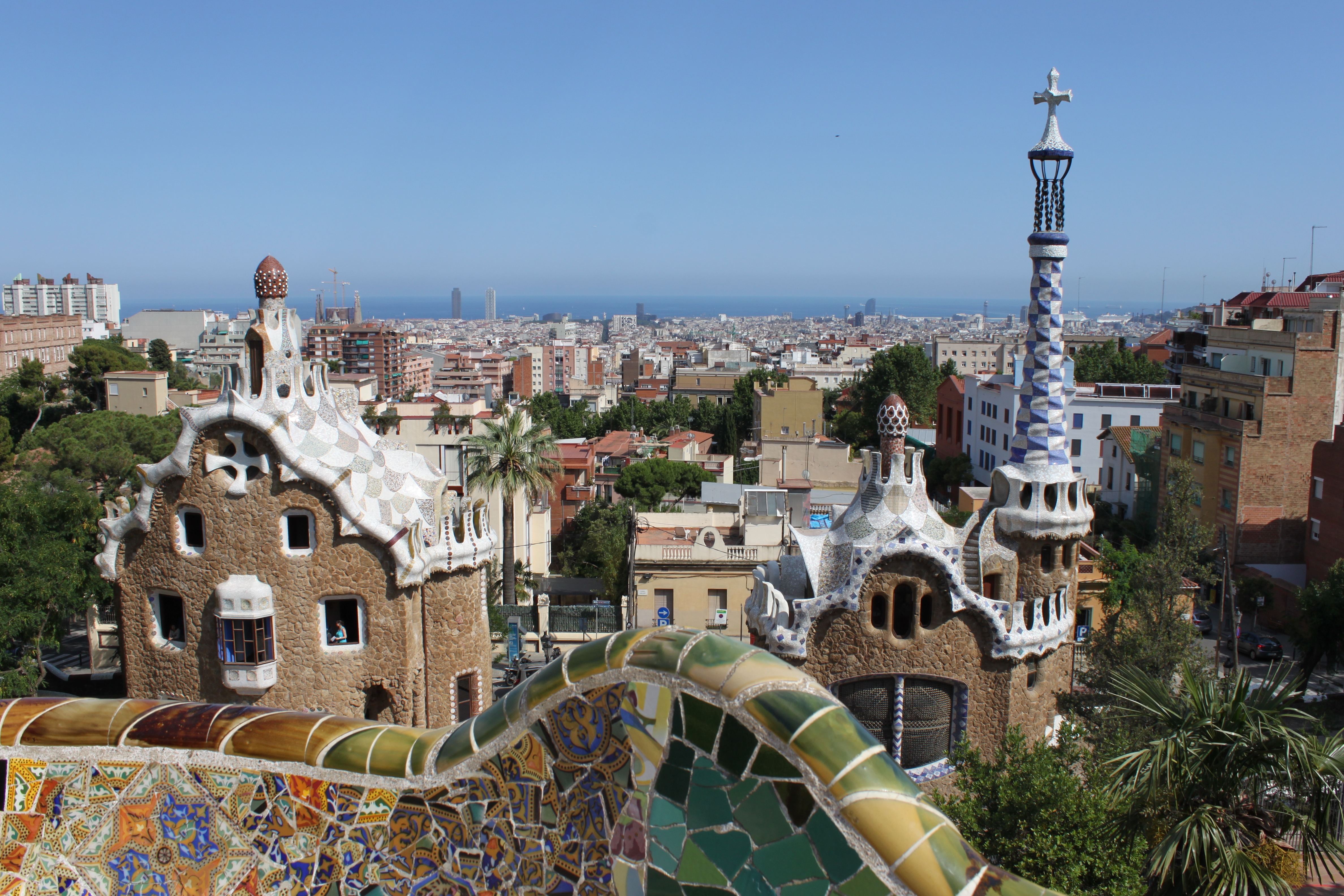Life in Barcelona
The City
 Barcelona - thanks to its location on the coast of the Mediterranean Sea - is synonymous with culture, a cosmopolitan atmosphere, urban design, and architecture. It is also a city that has a wide range of leisure activities available. For a brief history of the city, click here.
Barcelona - thanks to its location on the coast of the Mediterranean Sea - is synonymous with culture, a cosmopolitan atmosphere, urban design, and architecture. It is also a city that has a wide range of leisure activities available. For a brief history of the city, click here.
Practical Information
The practical information that follows will help students to safely enjoy their stay in Barcelona.
Students have a number of options to obtain cash in Euros (€):
- Credit cards
- Traveler’s checks
- Bank transfers
- ATMs (Cajeros automáticos)
Credit cards are handy but they carry a high interest rate, especially when used in ATMs for cash transfers abroad. Travelers' checks are more secure in case of theft, but banks often charge commissions to redeem them. Bank transfers to Spain (in addition to incurring a high commission), may take more than three days to process.
Therefore, the most convenient option is to withdraw money from ATMs with a debit card. Barcelona has many ATMs that can be used without having a bank account in Spain. In addition, it is useful to have a second (credit) card in case of theft or loss of the debit card. It is highly recommended to keep the second card in the safe at the student dorm.
Bank and savings bank hours: Monday to Friday, from 8am to 2pm. In the summer, they are also open on Thursdays until 6pm.
Barcelona is a well-connected city with an extensive, integrated public transport network. There are different ways to get around the city: metro, bus, tram, train and taxi.
Metro: This is the fastest way to get around the city. Barcelona's underground network covers almost the entire city and, in most cases, you can find a metro stop within minutes' walking distance. You can identify a metro station by the letter 'M' on a red diamond.
Bus: Barcelona's extensive bus network covers the whole city and beyond. A ride costs the same as the metro and the same ticket can be used.
Trams: Trams were reintroduced to the city in 1997. There are currently two tram networks that cover the outer limits of the city and beyond to the north and south, although work to connect the two networks started in March 2022.
Tickets: The same transport ticket is valid for travel all modes of public transport. You can change from one mode of transport to another during the same ride and have two hours' worth of traveling time per ride. You have to validate your ticket every time you wish to ride by inserting your ticket into the machines either at the turnstiles (metro/train) or onboard (bus/tram).
For all information regarding route, tickets and tariffs, visit the TMB (Transports Metropolitans de Barcelona) website.
Taxis: Barcelona taxis are black and yellow and have a green light on the roof which indicates whether they are available or not. Taxi fares don't start at zero; a ride always starts out from a set, base amount. To find a ride, all you have to do in most instances is find a strategic corner an flag down any taxi coming your way or use the "FreeNow" app. A ride to or from the city's airport is a flat rate: €35 from Terminal 1 and €30 from Terminal 2.
Food
Barcelona offers a wide range of restaurants and bars serving Catalan, Spanish and international meals. The city is, without a doubt, a paradise for lovers of good gastronomy.
One of the most common and cheap ways to eat is the menú del día, a fixed-price menu that includes two courses, a drink and a dessert. It always works out better than asking for each dish separately (à la carte). The day menu usually costs between €9 and €15. Some restaurants also offer this menu for dinner.
Another typical way to eat is tapas. Going for tapas is a pleasant way to share portions of different dishes with friends and, in some areas of Spain, the tradition of free tapas is still maintained.
Barcelona also has many supermarkets and markets, with stalls selling fruit, vegetables, fish, meat, cheeses, sausages and many other products, which are usually fresh and of good quality. The Boquería Market, on the Ramblas, is perhaps the best known, and also the most visited, in the city.
Buying groceries in a market is quite an experience because the products are fresh and prepared in front of the customer. In addition, they are places for socialization, where everyone talks to each other. Sellers always know the best way to prepare food, so ask for advice!
Schedules
Meals: breakfast, which usually consists of orange juice, bread or a sandwich and coffee, is served between 7 and 11 in the morning. The midday meal is the most important and largest meal of the day, and it is taken between 1 and 3:30pm. Dinner is later than in other European countries. Generally, restaurant kitchens do not open before 8:30pm, but serve dinner until 11:30pm (and sometimes even later).
Shopping: shops are open Monday through Saturday from 9am-2pm, then close at lunchtime. In the afternoon, the schedule is usually from 4:30 to 8:30pm. However, shopping centers and major brand stores in the city center are typically open throughout the day. On Sunday, the vast majority of stores are closed, except for some neighborhood supermarkets.
Work: Spaniards usually start working between 8am and 9am and also take a break to eat. In the afternoon, the workday lasts until 6 or 7pm.
Telephones
For safety and convenience, the program highly recommends that students have a cell phone during their time in Barcelona. Increasingly, students bring their smart phone from the U.S. and either use their U.S. number or buy a Spanish SIM card for the duration of their stay. It is advisable for students to contact their home service provider before departure to determine whether it offers any international plans. Buying a Spanish SIM (and, therefore, acquiring a Spanish cell number) is often times the cheaper option. There are mobile phone stores throughout the city and a basic phone plan can cost between €25 and €50/month. The price of the calls varies according to the operator, and it is always cheaper to call a mobile phone of the same company.
Students can buy stamps at tobacconists and at any post office. To send letters, students can use mailboxes that are on the street or at post offices. To send packages, students will have to go to a post office or use a courier service, which is much more expensive - but also a faster and safer option.
IMPORTANT: Sending a package to a student from the United States: It is advisable to use a reputable courier service rather than the U.S. Postal Service (USPS). When the package is sent via USPS, it is detained at customs and often the student has to pay taxes in order to be able to withdraw the package. For international dispatches, these means that packages are detained in Madrid making it more difficult for the student to retrieve any sent item. As taxes are declared/paid at source when using a courier service, it is a more secure and efficient way of sending items from the U.S.
Post offices
- Central Office: Via Laietana, 1. Tel: 93 310 04 04
- Post Office (near the CASA-Barcelona center): c / Valencia, 231. Tel: 93 215 39 20
- Post Office (near the residence): c / Consell de Cent, 445. Tel: 93 232 72 57
Press
The major newspapers/news web sites in Spanish are:
- El País: http://www.elpais.com/
- La Vanguardia: http://www.lavanguardia.es/
- El Periódico: http://www.elperiodico.com/
- ABC: http://www.abc.es/
- El Mundo: http://www.elmundo.es/
The primary sources of information in Catalan are:
- Avui: http://www.avui.cat
- VilaWeb: http://www.vilaweb.cat/
- El Periódico: http://www.elperiodico.cat/
- Ara: http://www.ara.cat/
Laptops
It is very common and convenient for students to bring laptops with them when studying in Barcelona. They will need to ensure that their laptop or power cord has an internal transformer. Before bringing it abroad, students should check with the manufacturer and take the proper measures to protect this valuable piece of equipment. Low quality power transformers can damage a student's laptop. To avoid problems with laptops, it is advisable to only recharge the battery when it is switched off, then use it once the battery is charged without plugging it in.
Electricity
Compared to the U.S., where the standard electric current is 110 volts/60 cycles, the most widespread electric current is 220 volts and 50 cycles. Electrical items brought from home will need to be adapted for European current and electrical outlets by use of both a transformer and a converter plug, which allows students to plug an American item into a European wall socket. Students will find that most electrical appliances (hair dryers, shavers, etc.) can be purchased in Barcelona for reasonable cost at any appliance store.
Internet
Internet, via WiFi connections, is available at the student hall of residence, the CASA-Barcelona center, the local universities as well as most cafés and restaurants.
Eduroam Wi-Fi
Eduroam is a global Wi-Fi connection provided by universities. If you install the Eduroam application while at your home university, you will have free internet access when at many international universities, including UAB, UB, UPC and UPF in Barcelona. Therefore, we encourage you to set up the Eduroam connection at your university before coming to Barcelona.
How to install Eduroam when at your home campus:
Barnard College
Brown University
Cornell University
Dartmouth College
Duke University
Harvard University
Johns Hopkins University
Northwestern University
University of Pennsylvania
The on-line publications below are just some of those that can be consulted to discover the most interesting events offered by the Ciudad Condal:
- For Free Barcelona: guide to free activities in Barcelona.
- Le Cool: a weekly newsletter with an alternative agenda.
- BCN Cultura: Barcelona City Council's cultural website.
- Time Out Barcelona: an essential guide to what's going on in the city.
- GuiaBCN: an essential guide to Barcelona that includes all the activities that the city offers.
- BCN: LGBTQ students can get more information on life, resources and what's on in Barcelona.
- The 10 Barcelonas: get to know the 10 city neighborhoods, the city's attractions, urban spaces, cultural and architectural heritage, natural spaces, museums and much more.
- Time out - Museums: a guide for free admission to museums.
Students can also read the CASA-Barcelona cultural blog, written by program students about their free time activities both in and around Barcelona and Spain. Their experiences and recommendations are very useful for newly arrived students, and an excellent way to find out first-hand what they can do during their semester in Barcelona.











